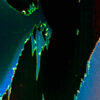There’s a kind of necessary amnesia that sets in after you finish writing a novel. Like childbirth, you must forget; the future requires it of you. If you remembered, really remembered, then surely you wouldn’t do it again. Or perhaps it’s that the experience itself of writing a novel is a kind of sustained forgetting, a controlled fugue.
I am reminded of a John Berger essay, ‘Seker Ahmet and the Forest’, from About Looking. Berger, in his essay, looks again and again at Ahmet’s late nineteenth-century painting, which depicts, in a haunting play of perspective, the forest as both classical landscape – self-contained scene with its edges visible in the distance – and a forest in all of its dark intractability, experienced not from the outside, but from within, by a woodcutter and his donkey passing through it, or as Berger suggests, swallowed by it. ‘The attraction and the terror of the forest,’ Berger writes, ‘is that you see yourself in it as Jonah was in the whale’s belly. Although it has limits, it is closed around you. Now this experience, which is that of anybody familiar with forests, depends upon your seeing yourself in double vision. You make your way through the forest and, simultaneously, you see yourself, as from the outside, swallowed by the forest.’
This ‘double vision’ is certainly an apt description of getting lost inside the world of one’s own novel – full immersion and a simultaneous awareness of the boundaries of that immersion. I often felt, in writing my novel Tides, that the simultaneity of attention necessary to shore up this imaginary world, to be both entirely inside, swallowed by the sentences and their atmosphere, and also very much outside of them, aware of the mouth doing the swallowing, amounted to a near impossible marriage of submission and control.
It strikes me as important that Berger’s description of the existential condition of the forest, as both unfathomable and circumscribed, is that experienced by those ‘familiar with forests’. But what of first-time woodcutters?
Although Tides is my first published novel, it is not, in fact, the first novel I wrote. In my late twenties, I worked for three years on another novel. I felt very passionately about this story, its potential. But for every tentative step, every new draft, I also felt entirely lost; I had little to contain my efforts. Being unfamiliar with forests, I had no sense of the forest’s edge, its necessary boundedness. I worked, not knowing how else to work, entirely from the inside, perfecting sentences and scenes, getting swallowed up by an interior landscape, with no sense of an overall design, a shape that might hold all I hoped I might be laboring towards. In the end, the book, its multiple perspectives, its loosely tethered sections, did not coalesce. I was left, instead, with three stands of trees, set apart from one another at an arbitrary distance – not a forest at all.
I’d identified, very late in the game, what Rachel Cusk, in her memoir Aftermath, calls a ‘flaw in the design’. Describing her own experience of ‘writing a novel wrong’, she writes: ‘The problem usually lies in the relationship between the story and the truth. The story has to obey the truth, to represent it, like clothes represent the body. The closer the cut, the more pleasing the effect.’ I’ve come to understand ‘the cut’ here to mean not merely the necessary containment of truth by story, but also the very shape that story must take, the vital artifice of form. I had thought, naively, that if I simply wrote truthfully about my carefully imagined characters, I could write a novel. Like in one of those most prosaic of anxiety dreams, I had arrived at the podium, ready to make my well-intentioned speech, looked down, only to find I’d forgotten to put on any clothes.
I mourned. I didn’t write for a year. I forgot.
And then, having forgotten, I tried again. One character this time, a simple enough story, a woman who leaves her life behind in the aftermath of an irreparable series of ruptures. In other words, a smaller forest, one I suspected I might be able to get lost in without losing myself entirely. It would be a lie to say it went well. I still did not know how to write a novel. I made artificial boundaries. The story, in its first iteration, moved, like a pendulum, from past to present giving equal weight to each, for no reason at all – a shape that was not moved from the inside but imposed from the outside, a clumsy act of will. But I forged ahead, like the donkey in Seker Ahmet’s painting, loyal to the woodcutter I hoped I might become. When I reread that draft, a few months later, I found, in all of its pages, only a handful of sentences worth saving. I was devastated, or angry – maybe both.
I demurred. I dug my hooves in. I thought of giving up.
And yet, once I’d recovered from the shame of it – how much work, and how little of it seemed salvageable – I realized I had my character. And perhaps more importantly I had a few sentences, a dozen maybe, so strange to me, so right, they seemed to have been written by a different writer, one I might want to become.
I return again and again to Annie Dillard’s injunction from The Writing Life: ‘Process is nothing; erase your tracks. The path is not the work. I hope your tracks have grown over; I hope birds ate the crumbs; I hope you will toss it all and not look back.’ I did just this. I opened a new document, and wrote, keeping only those few strange, salvaged sentences in mind, their dislocated urgency, and rather quickly, a forest, a real one, attractive and terrifying, emerged. And then something even more unexpected occurred: while I wrote these new, odd sentences – mine but not, which in their strange autonomy seemed to write themselves – I was aware, too, of the borders taking shape around what I wrote, a sense of the whole somehow taking hold from the inside, encircling my efforts from the outside. Not only had the story found a form that captured its truth, the truth of the story had emerged from the form itself, from the sound and cadence of the sentences, their lonely placement on the page. I had found my double vision.
By the end, I didn’t know if I loved what I had written, but I knew that I had written something, something both inhabitable, a place with a very particular atmosphere, an eerie play of shadow and light, and something with an outward concreteness, a shape that cohered just enough to be called a story.
These days, I stalk the periphery of a new forest, attracted, terrified. By now, I hope I have forgotten just enough to consider doing it again.
Image © Simon G.Bradley Roberts








